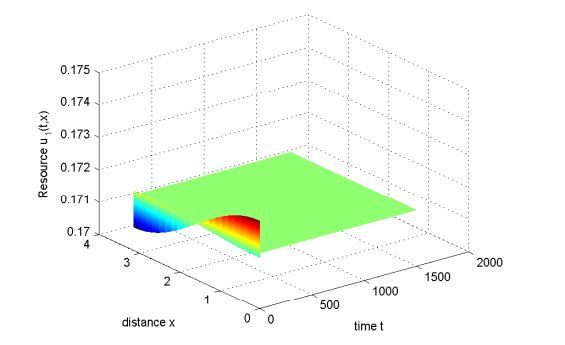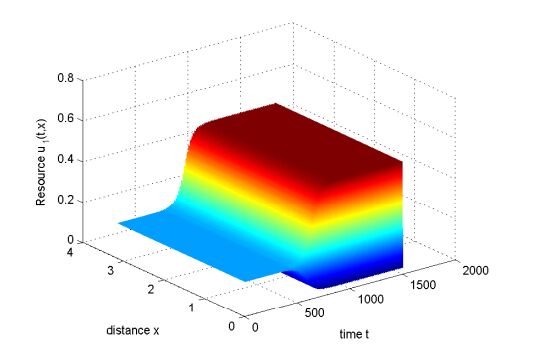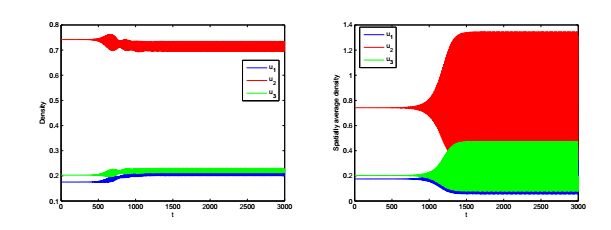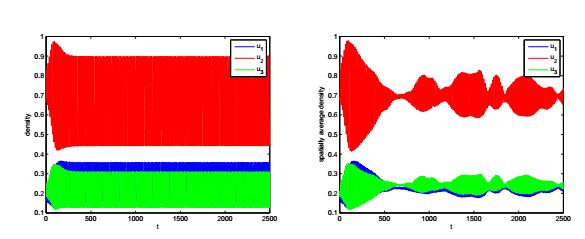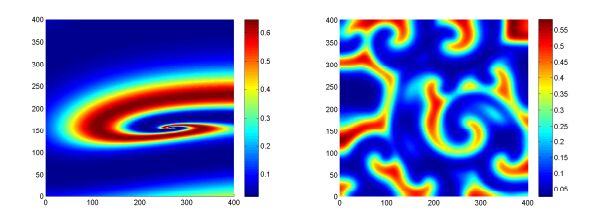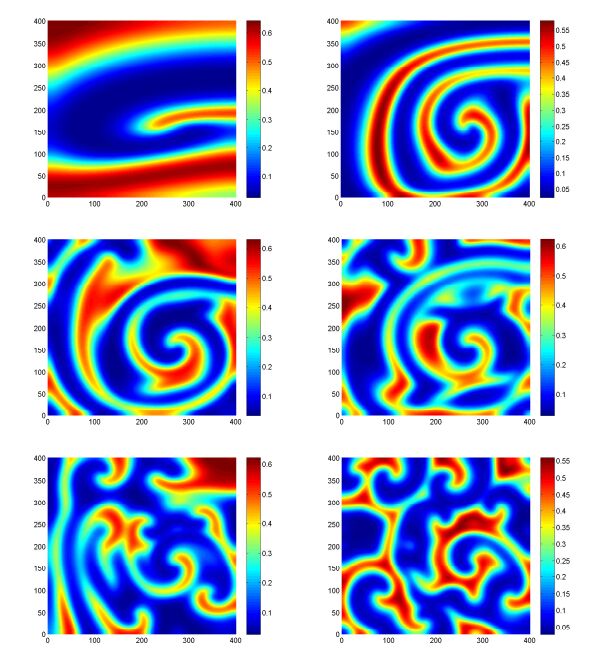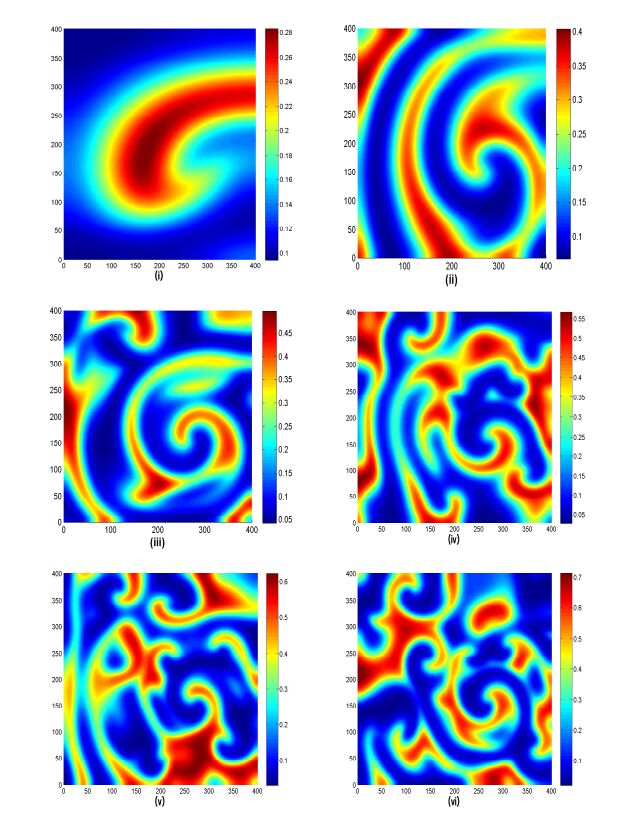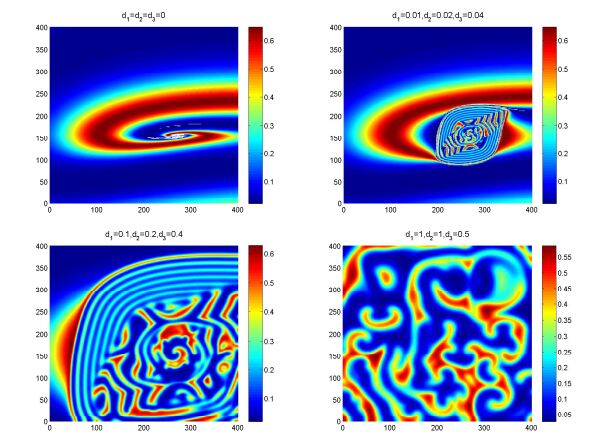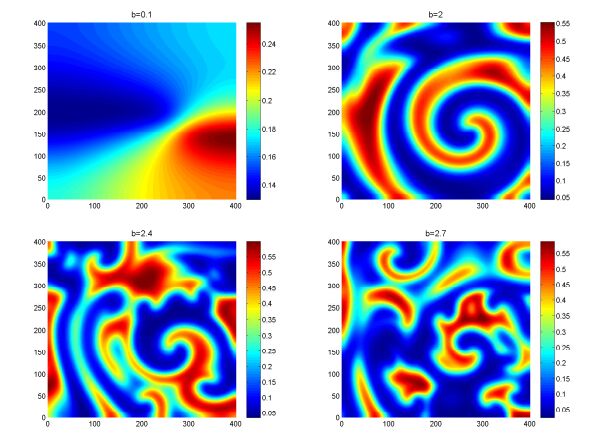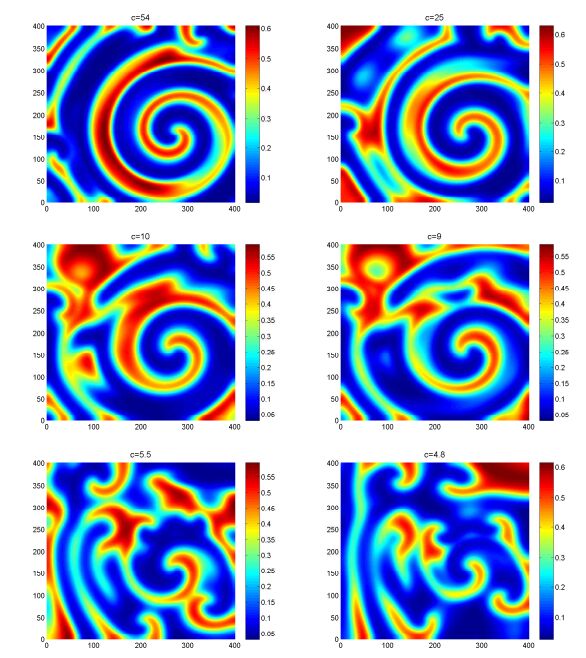1. Introduction
Competition and predation are two fundamental ecological relationships among species and have been widely studied [1]. Recently, it is been recognized that intraguild predation (IGP), which is a combination of competition and predation, has significant impacts on the distribution, abundance, persistence and evolution of the species involved [2]. As a result, growing attention has been paid to IGP models [3,4,5,6,7,8,9].
The general framework of IGP described below was established by Holt and Polis [5]
|
{˙R(t)=R(φ(R)−ρ1(R,N,P)N−ρ2(R,N,P)P),˙N(t)=N(e1ρ1(R,N,P)R−ρ3(R,N,P)P−m1),˙P(t)=P(e2ρ2(R,N,P)R+e3ρ3(R,N,P)N−m2),
|
(1)
|
where R(t),N(t),P(t) represent the densities of basal resource, IG prey and IG predator, respectively. The quantities ρ2(R,N,P)R and ρ3(R,N,P)N are functional responses of the IG predator to the resource and IG prey, respectively; ρ1(R,N,P)R is the functional response of the IG prey to the basal resource; and m1 and m2 are density-independent morality rates. The parameters e1 and e2 are the conversion rates of resource consumption into reproduction for the IG prey and IG predator, respectively; the parameter e3 denotes the conversion rate of the IG predator from its consumption of IG prey; Rφ(R) is recruitment of the basal resource.
Functional response describes how the consumption rate of individual consumers varies with respect to resource density and is often used to model predator-prey interactions. For IGP models, several functional response functions have been studied. For instance, Velazquez et al. [10] and Hsu et al. [11] investigated the case with a linear functional response. Abrams and Fung [12] considered Holling type-II functional response. Verdy and Amarasekare [13] and Freeze et al. [14] investigated Holling type-II and ratio-dependent functional responses, respectively. Kang and Wedekin [15] considered Holling-III functional response.
Note that the reproduction of predator following the consumption of prey is not instantaneous, but rather is mediated by some reaction-time lag required for gestation. Time delay plays an important role in ecology and it can induce very complex dynamical behaviors [16,17,18,19,20,21,22]. For IGP models, it has been shown that a time delay greatly impacts their dynamics [23,24]. In [24], Shu et al. investigated the complex dynamics of the following IGP model
|
{˙R(t)=rR(t)(1−R(t)K)−c1R(t)N(t)−c2R(t)P(t),˙N(t)=e1c1R(t−τ)N(t−τ)−c3N(t)P(t)−m1N(t),˙P(t)=e2c2R(t)P(t)+e3c3N(t)P(t)−m2P(t),
|
(2)
|
where r is the growth rate of R in the absence of N and P, K is the carrying capacity of resource. c1 is the predation rate of IG prey for resource, c2 is the predation rate of IG predator for resource, c3 is the consumption rate of IG predator to IG prey and all other parameters have the same meanings as those in (1).
Note that for each species, individuals tend to migrate towards regions with lower population densities. Hence the species are distributed over space and interact with each other within their spatial domains. To take spatial effects into consideration, reaction diffusion equations become a natural choice [25,26,27,28,29,30,31,32,33,34,35,36]. In this work, we consider a reaction diffusion IGP model with delay and Beddington-DeAngelis functional response.
Suppose Ω⊂Rn is a bounded domain with smooth boundary ∂Ω. Let R(t,x), N(t,x), P(t,x) represent the densities of basal resource, IG prey and IG predator at time t and location x, respectively. The basal resource is assumed to grow logistically. We assume the basal resource is consumed by the IG prey at a rate c1R(t,x)N(t,x), and the IG prey is consumed by the IG predator is c3N(t,x)P(t,x) at time t and location x. In this paper, we will assume the functional response takes the Beddington-DeAngelis (B-D) form, i.e., the consumption of the resource by the IG predator is characterized by c2P(t,x)R(t,x)1+a1R(t,x)+a2P(t,x). The reproduction of IG prey from consuming the basal resource is e1c1R(t−τ,x)N(t−τ,x), where the time-lag parameter is introduced in a manner analogous to the treatment in [24]. We further assume the populations cannot cross the boundary of Ω. Our model then reads as
|
{∂R(t,x)∂t=˜d1ΔR+R(r(1−RK)−c1N−c2P1+a1R+a2P),t>0,x∈Ω∂N(t,x)∂t=˜d2ΔN+e1c1N(t−τ,x)R(t−τ,x)−c3NP−m1N,t>0,x∈Ω,∂P(t,x)∂t=˜d3ΔP+P(e2c2R1+a1R+a2P+e3c3N−m2),t>0,x∈Ω,∂R∂ν=∂N∂ν=∂P∂ν=0,t>0,x∈∂Ω,R(t,x)=˜ϕ1(t,x)≥0,(t,x)∈[−τ,0]×Ω,N(t,x)=˜ϕ2(t,x)≥0,(t,x)∈[−τ,0]×Ω,P(t,x)=˜ϕ3(t,x)≥0,(t,x)∈[−τ,0]×Ω,
|
(3)
|
where ˜d1,˜d2,˜d3 denote the diffusion coefficients of the three species, respectively; Δ is the Laplacian operator in the n dimensional space, ν is the outward unit normal vector on ∂Ω, and the homogeneous Neumann boundary conditions reflect the situation where the population cannot across the boundary of Ω. The meanings and units of the parameters of model (3) are summarized in Table 1.
Table 1. Parameters definitions in model (3) and their units, where [resource] indicates basal resource density, [IG prey] indicates IG prey density, and [IG predator] indicates IG predator density.
| Symbol |
Parameter Definition |
Units |
| r |
Basal resource intrinsic growth rate |
[time]−1 |
| K |
Basal resource carrying capacity |
[Basal resource density] |
| c1 |
Predation rate of IG prey on resource |
[IG prey]−1 [time]−1 |
| c2 |
Predation rate of IG predator on resource |
[IG predator]−1[time]−1 |
| c3 |
Predation rate of IG predaotr on IG prey |
[IG preys][IG predator]−1 |
|
|
[time]−1 |
| e1 |
Conversion rate from resource to IG prey |
[IG preys][resource]−1 |
| e2 |
Conversion rate from resource to IG predator |
[IG predators][resource]−1 |
| e3 |
Conversion rate from IG prey to IG predator |
[IG predators][IG prey]−1 |
| a1 |
[Half saturation constant]−1 |
[resource]−1 |
| a2 |
[Half saturation constant]−1 |
[IG predator]−1 |
| m1 |
Mortality rate of IG prey |
[time]−1 |
| m2 |
Mortality rate of IG predator |
[time]−1 |
| ˜d1 |
Diffusion coefficient of resource |
[length]2[time]−1 |
| ˜d2 |
Diffusion coefficient of IG prey |
[length]2[time]−1 |
| ˜d3 |
Diffusion coefficient of IG predatior |
[length]2[time]−1 |
| L |
The size of spatial domain Ω |
[length] |
For rescalling, we let
|
u1(t,x)=R(t,x)K,u2(t,x)=c1N(t,x)r,u3(t,x)=c2P(t,x)r,γ1=m1r,γ2=m2r,β1=e1c1Kr,β2=e2c2Kr,α=c3c2,β=e3c3c1,b=a1K,c=a2rc2,d1=˜d1rL2,d2=˜d2rL2,d3=˜d3rL2,ˆx=xL,ˆt=tr,ˆτ=τr,ϕ1(t,x)=˜ϕ1(t,x)K,ϕ2(t,x)=c1˜ϕ2(t,x)r,ϕ3(t,x)=c2˜ϕ3(t,x)r.
|
Then model (1.3) becomes
|
{∂u1(t,x)∂t=d1Δu1(t,x)+f1(u,v),t>0,x∈Ω,∂u2(t,x)∂t=d2Δu2(t,x)+f2(u,v),t>0,x∈Ω,∂u3(t,x)∂t=d3Δu3(t,x)+f3(u,v),t>0,x∈Ω,∂u1(t,x)∂ν=∂u2(t,x)∂ν=∂u3(t,x)∂ν=0,t>0,x∈∂Ω,u1(t,x)=ϕ1(t,x)≥0,(t,x)∈[−τ,0]×Ω,u2(t,x)=ϕ2(t,x)≥0,(t,x)∈[−τ,0]×Ω,u3(t,x)=ϕ3(t,x)≥0,(t,x)∈[−τ,0]×Ω,
|
(4)
|
where u=(u1(t,x),u2(t,x),u3(t,x)),v=(u1(t−τ,x),u2(t−τ,x)) and
|
f1(u,v)=u1(t,x)(1−u1(t,x)−u2(t,x)−u3(t,x)1+bu1(t,x)+cu3(t,x)),
|
|
f2(u,v)=β1u1(t−τ,x)u2(t−τ,x)−αu2(t,x)u3(t,x)−γ1u2(t,x),
|
|
f3(u,v)=u3(t,x)(β2u1(t,x)1+bu1(t,x)+cu3(t,x)+βu2(t,x)−γ2).
|
Throughout the paper, we denote ˉΩ=Ω⋃∂Ω, DT=(0,T]×Ω,ˉDT=[0,T]×ˉΩ, Q0=[−τ,0]×Ω,ˉQ0=[−τ,0]×ˉΩ, QT=[−τ,T]×Ω,ˉQT=[−τ,T]×ˉΩ. Denote by Cγ(DT) the space of Hölder continuous functions in DT with exponent γ∈(0,1). The space of continuous functions in ˉDT is denoted by C(ˉDT). For vector-value functions we use the product spaces
|
C(ˉDT)≡C(ˉDT)×C(ˉDT)×C(ˉDT),Cγ(ˉDT)≡Cγ(ˉDT)×Cγ(ˉDT)×Cγ(ˉDT).
|
Denote
|
X={(u1,u2,u3)T∈H2(Ω)×H2(Ω)×H2(Ω):∂u1∂ν=∂u2∂ν=∂u3∂ν=0on∂Ω}
|
with the usual inner product ⟨⋅,⋅⟩.
The rest of the paper is organized as follows. In Section 2, we study the existence and uniqueness of solution of (4) and estimate the solution's priori bounds. In Section 3, we discuss the existence of nonnegative spatially homogeneous steady states. In Section 4, we carry out stability analysis and Hopf bifurcation analysis about the unique positive spatially homogeneous steady state of System (4). Numerical simulations are presented in Section 5 to illustrate the impacts of delay, diffusion and the functional response on the dynamics of our IGP model. We conclude this paper with a brief summary and discussion in Section 6.
2. Existence of solution of System (4) and priori bound estimation
Theorem 2.1. Consider System (4), we have the following conclusions.
(ⅰ) Given any initial condition (ϕ1(t,x),ϕ2(t,x),ϕ3(t,x))∈Cγ(Q0) with
|
0≤ϕi(t,x)≤Li,(t,x)∈Q0,i=1,2,3,
|
(5)
|
where Li,i=1,2,3 are positive constants satisfying
|
1≤L1≤γ1β1,L2<γ2β,L3≥1c[β2L1γ2−βL2−bL1−1],
|
(6)
|
System (4) admits a unique solution (u1(t,x),u2(t,x),u3(t,x)) satisfying
|
0≤ui(t,x)≤Li,fort>0,x∈Ω,i=1,2,3.
|
(ⅱ) For any solution (u1(t,x),u2(t,x),u3(t,x)) of System (4), it holds true that
|
lim supt→∞u1(t,x)≤1,lim supt→∞∫Ωu2(t,x)dx≤J1,lim supt→∞∫Ωu3(t,x)dx≤J2
|
where J1=(β14γ1+β1)|Ω|, J2=(β24κ+β1βακJ1+β2)|Ω| with κ=min{γ1,γ2}.
Furthermore, if d1=d2=d3 and τ=0, then for any x∈ˉΩ,
|
lim supt→∞u2(t,x)≤β2α4κβ+β1κ(β14γ1+β1)+β2αβ,lim supt→∞u3(t,x)≤β24κ+β1βακ(β14γ1+β1)+β2.
|
Proof. Note that fi(u,v) is mixed quasi-monotone in a subset Λ×Λ∗ of R3×R2 for each i=1,2,3, we can apply [27,Therorem 2.2] to establish the existence and uniqueness of solutions to System (4). To this end, we first need to construct a pair of coupled upper and lower solutions of System (4), which we denote by (˜u1,˜u2,˜u3) and (ˆu1,ˆu2,ˆu3), respectively. In view of [27,Definition 2.1], the required upper and lower solutions should satisfy the boundary-initial inequalities and the following differential inequalities
|
{∂˜u1∂t≥d1Δ˜u1+˜u1(1−˜u1−ˆu2−ˆu31+b˜u1+cˆu3)∂~u2∂t≥d2Δ˜u2+β1˜u1˜u2−αˆu3˜u2−γ1˜u2,∂˜u3∂t≥d3Δ˜u3+β2˜u1˜u31+b˜u1+c˜u3+β˜u2˜u3−γ2˜u3
|
(7)
|
and
|
{∂ˆu1∂t≤d1Δˆu1+ˆu1(1−ˆu1−˜u2−˜u31+bˆu1+c˜u3)∂ˆu2∂t≤d2Δˆu2+β1ˆu1ˆu2−α˜u3ˆu2−γ1ˆu2∂ˆu3∂t≤d3Δˆu3+β2ˆu1ˆu31+bˆu1+cˆu3+βˆu2ˆu3−γ2ˆu3.
|
(8)
|
Take (ˆu1,ˆu2,ˆu3)=(0,0,0) and (˜u1,˜u2,˜u3)=(L1,L2,L3). Clearly, ∂˜ui∂ν=0≥0≥0=∂ˆui∂ν. It follows from (5) and (6) that the pair (ˆu1,ˆu2,ˆu3)=(0,0,0) and (˜u1,˜u2,˜u3)=(L1,L2,L3) are coupled upper and lower solutions of System (4). It is easy to check that fi(u,v)(i=1,2,3) satisfy the Lipschitz condition for 0≤ui≤Mi,0≤vi≤Li,i=1,2,3, and we denote the Lipschitz constants by Ki,i=1,2,3. By [27,Theorem 2.2], System (4) admits a unique global solution (u1(t,x),u2(t,x),u3(t,x)), which satisfies
|
(0,0,0)≤(u1(t,x),u2(t,x),u3(t,x))≤(L1,L2,L3),t≥0,x∈Ω.
|
This completes the proof of (ⅰ).
Next we establish the priori bound of solutions to System (4). To estimate u1(t,x), we observe that u1(t,x) satisfies
|
{∂u1(t,x)∂t≤d1Δu1(t,x)+u1(t,x)(1−u1(t,x)),t>0,x∈Ω,∂u1(t,x)∂n=0,t>0,x∈∂Ω.
|
It follows from the standard comparison principle [37,Lemma 3.4.2] of parabolic equations that lim supt→∞u1(t,x)≤1. Thus for any ε>0, there exists a T1>0 such that u1(t,x)≤1+ε for t≥T1.
To estimate the priori bounds of u2(t,x) and u3(t,x), we set
|
U1(t)=∫Ωu1(t,x)dx,U2(t)=∫Ωu2(t,x)dx,U3(t)=∫Ωu3(t,x)dx.
|
Then
|
dU1(t)dt=∫Ω∂u1∂tdx=∫Ωd1Δu1dx+∫Ω[u1(t,x)(1−u1(t,x)−u2(t,x)−u3(t,x)1+bu1(t,x)+cu3(t,x))]dx,
|
|
dU2(t)dt=∫Ω∂u2∂tdx=∫Ωd2Δu2dx+∫Ω[β1u1(t−τ,x)u2(t−τ,x)−αu2(t,x)u3(t,x)−γ1u2(t,x)]dx,
|
|
dU3(t)dt=∫Ω∂u3∂tdx=∫Ωd3Δu3dx+∫Ω[u3(t,x)(β2u1(t,x)1+bu1(t,x)+cu3(t,x)+βu2(t,x)−γ2)]dx.
|
From the Neumann boundary conditions, we further obtain
|
d(β1U1(t)+U2(t+τ))dt=β1∫Ω∂u1∂tdx+∫Ω∂u2(t+τ,x)∂tdx=β1∫Ω(u1−u21)dx−∫Ωβ1u1u31+bu1+cu3dx−∫Ωαu2(t+τ,x)u3(t+τ,x)dx−∫Ωγ1u2(t+τ,x)dx≤β14|Ω|+γ1β1(1+ε)|Ω|−γ1(β1U1(t)+U2(t+τ)),t>T1.
|
By the comparison principle, we have
|
lim supt→∞(β1U1(t)+U2(t+τ))≤β14γ1|Ω|+β1|Ω|≡J1.
|
Similarly, there exists T2>T1 such that ∫Ωu2(t,x)dx=U2(t)≤J1+ε for t≥T2. Thus, for t≥T2+τ, we have
|
d(β2U1(t)+βαU2(t)+U3(t))dt=β2∫Ω(u1−u21)dx+∫Ωβ1βαu1(t−τ,x)u2(t−τ,x)dx−βγ1α∫Ωu2dx−γ2∫Ωu3dx≤β24|Ω|+β1βα(1+ε)∫Ωu2(t−τ,x)dx−βγ1αU2−γ2U3≤β24|Ω|+β1βα(1+ε)(J1+ε)|Ω|+β2κ(1+ε)|Ω|−κ(β2U1+βαU2+U3),
|
where κ=min{γ1,γ2}. This implies that
|
lim supt→∞(β2U1+βαU2+U3)≤β24κ|Ω|+β1βακJ1|Ω|+β2|Ω|≡J2.
|
and hence lim supt→∞∫Ωu3(t,x)dx=lim supt→∞U3(t)≤J2.
For the case with d1=d2=d3=d and τ=0, we can similarly show that for any ε>0, there exists T3>T1 such that 0≤u1(t,x)≤1+ε and 0≤u2(t,x)≤β14γ1+β1 for t>T3. Moreover, let S(t,x)=β2u1(t,x)+βαu2(t,x)+u3(t,x). Then
|
{∂S∂t=dΔS+β2(u1−u21)−β2u1u2+ββ1αu1u2−βγ1αu2−γ2u3,t>T3,x∈Ω,∂S∂ν=0,t>T3,x∈∂Ω,S(T3,x)=β2u1(T3,x)+βαu2(T3,x)+u3(T3,x),x∈Ω.
|
Thus for t>T3, we have
|
β2(u1−u21)−β2u1u2+ββ1αu1u2−βγ1αu2−γ2u3≤β24+β1βα(1+ε)(β14γ1+β1+ε)+β2κ(1+ε)−κS.
|
Consider the system
|
{∂W∂t=dΔW+β24+β1βα(1+ε)(β14γ1+β1+ε)+β2κ(1+ε)−κW,t>T3,x∈Ω∂W∂ν=0,t>T3,x∈∂Ω,W(T3,x)=β2u1(T3,x)+βαu2(T3,x)+u3(T3,x),x∈Ω.
|
It follows from [37,Theorem 2.4.6] that the solution W(t,x) satisfies
|
limt→∞W(t,x)=β24κ+β1βακ(1+ε)(β14γ1+β1+ε)+β2(1+ε).
|
The comparison argument implies that
|
lim supt→∞u2(t,x)≤lim supt→∞αβS(t,x)≤β2α4κβ+β1κ(β14γ1+β1)+β2αβ
|
and
|
lim supt→∞u3(t,x)≤lim supt→∞S(t,x)≤β24κ+β1βακ(β14γ1+β1)+β2.
|
This completes the proof.
3. Spatially homogeneous steady states of System (4)
Same as in [24], we denote by Ri=βiγi=eiciKmi(i=1,2) the reproduction numbers for the IG prey and IG predator, respectively. Consider (4), we easily have the following existence results on trivial and semi-trivial spatially homogeneous steady states.
Proposition 1. (ⅰ) The trivial steady state E0=(0,0,0) always exists.
(ⅱ) There is a weakly semi-trivial steady state in the absence of IG Prey and IG Predator E1=(1,0,0).
(ⅲ) The IG Prey-only strong semi-trivial steady state E10:=(1R1,1−1R1,0) exists if and only if R1>1.
(ⅳ) The IG Predator-only strong semi-trivial steady state E01:=(ˆu1,0,R2(1−ˆu1)ˆu1) exists if and only if R2>1+b, where
|
ˆu1=−(R2−cR2−b)+√(R2−cR2−b)2+4cR22cR2.
|
System (4) admits a positive steady state E∗:=(u∗1,u∗2,u∗3) if E∗ is a positive solution to the following three equations:
|
1−u1−u2−u31+bu1+cu3=0,
|
(9)
|
|
β2u11+bu1+cu3+βu2−γ2=0.
|
(11)
|
It follows from (10) that
Combining (9), (10) and (12), we obtain
where
|
p=cγ2β21+bαβ1(γ2−β)+αβ1(β−β2)+cββ1(γ1−β1)+ββ21+2bαβγ1αβ(bα+cβ1),q=β21(γ2−β)+bβ1γ1(γ2−β)+β1γ1(β−β2)+β(bγ21−β21)αβ(bα+cβ1).
|
For the distribution of roots of Eq. (13), we have the following results.
Lemma 3.1. (ⅰ) If p<0,p2−4q>0 and q>0, then Eq. (13) has two positive roots u∗3±=−p±√p2−4q2.
(ⅱ) If p<0 and p2−4q=0, then Eq. (13) has a unique positive root u∗30=−p2.
(ⅲ) If q<0, then Eq. (13) has a unique positive root u∗3=u∗3+.
Remark 1. Set R3=βγ2, then q<0 provided that R1>b and R2>R3>1.
According to Lemma 3.1, the following proposition is valid.
Proposition 2. (ⅰ) When p2−4q>0,p<0,q>0 and
|
R2<min{(bα+cβ1)(−p+√p2−4q)+2(bγ1+β1)α(−p+√p2−4q)+2γ1,(bα+cβ1)(−p−√p2−4q)+2(bγ1+β1)α(−p−√p2−4q)+2γ1}
|
System (4) has two positive constant steady states E∗+=(u∗1+,u∗2+,u∗3+) and
|
E∗−=(u∗1−,u∗2−,u∗3−),whereu∗1+=αu∗3++γ1β1,u∗2+=γ2β−β2β×αu∗3++γ1(bα+cβ1)u∗3++bγ1+β1,u∗3+=−p+√p2−4q2andu∗1−=αu∗3−+γ1β1,u∗2−=γ2β−β2β×αu∗3−+γ1(bα+cβ1)u∗3−+bγ1+β1,u∗3−=−p−√p2−4q2.
|
(ⅱ) When p2−4q=0,p<0 and R2<−(bα+cβ1)p+2(bγ1+β1)2γ1−αp, E∗+ and E∗− merge, denoted by E∗0=(u∗10,u∗20,u∗30), where u∗10=−pα2β1+γ1β1,u∗20=γ2β−β2β2γ1−pα2(bγ1+β1)−(bα+cβ1)p,u∗30=−p2.
(ⅲ) When q<0 and R2<(bα+cβ1)(−p+√p2−4q)+2(bγ1+β1)α(−p+√p2−4q)+2γ1, System (4) has only one positive constant steady state E∗=(u∗1,u∗2,u∗3), where u∗1=u∗1+,u∗2=u∗2+,u∗3=u∗3+.
Remark 2. There exist parameter values such that Proposition 3.4 holds. For example, choosing α=0.68,β=0.9,β1=1.9,β2=1.8,γ1=0.2,γ2=0.76,,b=2.5,c=10. A direct calculation yields only one positive steady state
|
E∗=(0.1891,0.7562,0.2344).
|
4. Dynamics of System (4)
Let 0=μ1<μ2≤μ3≤⋯ be the eigenvalues of −Δ on Ω under no-flux boundary conditions, and E(μi) be the eigenspace corresponding to μi with multiplicity mi≥1,i∈N≡{1,2,⋯}. Set Xij:={e⋅ϕij:e∈R3}, where {ϕij} is an orthonormal basis of E(μi) for j=1,2,⋯,dimE(μi). For X:={w∈C1(ˉΩ):∂w1∂ν=∂w2∂ν=∂w3∂ν=0on∂Ω}, we have the following lemma from [37].
Lemma 4.1.
|
X=∞⊕i=1Xi,whereXi=dimE(μi)⊕j=1Xij.
|
4.1. Stability of E0 and E1
In the following, we consider the stability of E0 and E1.
Theorem 4.2.
(ⅰ) The trivial steady state E0 is always unstable.
(ⅱ) The semi-trivial steady state E1 is locally asymptotically stable if R1<1 and R2<1+b and unstable if either R1>1 or R2>1+b.
Proof. Linearizing System (4) at a constant steady state u⋄=(u⋄1,u⋄2,u⋄3) gives
|
∂u∂t=(DΔ+ˆJ1)u+ˆJ2uτ,
|
(14)
|
where D=diag{d1,d2,d3},u=(u1(t,x),u2(t,x),u3(t,x)),uτ=(u1(t−τ,x),u2(t−τ,x),u3(t−τ,x) and
|
ˆJ1=[1−2u⋄1−u⋄2−u⋄3+cu⋄32(1+bu⋄1+cu⋄3)2−u⋄1−(1+bu⋄1)u⋄1(1+bu⋄1+cu⋄3)20−αu⋄3−γ1−αu⋄2β2(1+cu⋄3)u⋄3(1+bu⋄1+cu⋄3)2βu⋄3β2u⋄1(1+bu⋄1)(1+bu⋄1+cu⋄3)2+βu⋄2−γ2],ˆJ2=[000β1u⋄2β1u⋄10000].
|
From Lemma 4.1, we know that the eigenvalues of the System (4) is confined on the subspace Xi, and λ is an eigenvalue of (14) on Xi if and only if it is an eigenvalue of the matrix −μiD+J∗, where J∗=ˆJ1+ˆJ2e−λτ. Then the characteristic equation of (14) is
where I3 stands for the 3×3 identity matrix.
(ⅰ) If u⋄=E0, then we obtain the following characteristic equation
|
(λ+d1μi−1)(λ+d2μi+γ1)(λ+d3μi+γ2)=0,
|
which gives three sets of eigenvalues, namely, λ1i=−d1μi+1,λ2i=−d2μi−γ1,λ3i=−d3μi−γ2,i=1,2,⋯. Clearly, for i=1, λ11=1>0. From [40,Corollary 1.11], the trivial steady state E0 is unstable.
(ⅱ) If u⋄=E1, then we obtain the following characteristic equation
|
(λ+d1μi+1)(λ+d2μi−β1e−λτ+γ1)(λ+d3μi−β21+b+γ2)=0,
|
which gives the eigenvalues λ1i=−d1μi−1,λ3i=−d3μi+β21+b−γ2 and λ2i is determined by λ2i+d2μi+γ1−β1e−λ2iτ=0. Clearly, λ1i<0 for all μi. If R2<1+b, we get λ3i<0 for all μi. If R1<1, then we have β1<γ1+d2μi for all μi. Thus it follows from [24,Lemma 6] that the eigenvalues λ2i have negative real parts for all μi. It follows from [40,Corollary 1.11] that the equilibrium E1 is locally asymptotically stable for R1<1 and R2<1+b. If R1>1 then there exists μ1=0 such that d2μ1+γ1<β1, so it follows from the [24,Lemma 6] that at least one of the eigenvalues λ2i has a positive real part. If R2>1+b then there exists μ1=0 such that λ31>0. From [40,Corollary 1.11], the steady state E1 is unstable in either case.
Theorem 4.3. Suppose that R1<1,R2<1+b and 1−γ2β>1c. Then E1 is globally asymptotically stable.
Proof. Let (ˆu1,ˆu2,ˆu3)=(ε,0,0) and (˜u1,˜u2,˜u3)=(M1,M2,M3), where M1=1+ε<γ1β1,M2=γ2β−ε>0, M3=1c(β2M1γ2−βM2−bM1−1)=1c(β2(1+ε)βε−b(1+ε)−1) >0 and ε is arbitrary small positive constant.
We claim that (ˆu1,ˆu2,ˆu3)=(ε,0,0) and (˜u1,˜u2,˜u3)=(M1,M2,M3) are also coupled upper and lower solutions of System (4). In fact, it follows from 1−γ2β>1c that 1−γ2β>M31+cM3, and thus we get ε(1−ε−(γ2β−ε)−M31+bε+cM3)≥0. Hence, we obtain ˆu1(1−ˆu1−˜u2−˜u31+bˆu1+c˜u3)≥0. It is easy to check that (ˆu1,ˆu2,ˆu3)=(ε,0,0) and (˜u1,˜u2,˜u3)=(M1,M2,M3) satisfy the differential inequalities in (7) and (8). Thus the claim holds. Define the iterated sequences (ˉu(m)1,ˉu(m)2,ˉu(m)3) and (u_(m)1,u_(m)2,u_(m)3) as follows:
|
ˉu(m)1=ˉu(m−1)1+1K1[ˉu(m−1)1(1−ˉu(m−1)1−u_(m−1)2−u_(m−1)31+bˉu(m−1)1+cu_(m−1)3)],u_(m)1=u_(m−1)1+1K1[u_(m−1)1(1−u_(m−1)1−ˉu(m−1)2−ˉu(m−1)31+bu_(m−1)1+cˉu(m−1)3)],ˉu(m)2=ˉu(m−1)2+1K2[ˉu(m−1)2(β1ˉu(m−1)1−αu_(m−1)3−γ1)],u_(m)2=u_(m−1)2+1K2[u_(m−1)2(β1u_(m−1)1−αˉu(m−1)3−γ1)],ˉu(m)3=ˉu(m−1)3+1K3[ˉu(m−1)3(β2ˉu(m−1)11+bˉu(m−1)1+cˉu(m−1)3+βˉu(m−1)2−γ2)],u_(m)3=u_(m−1)3+1K3[u_(m−1)3(β2u_(m−1)11+bu_(m−1)1+cu_(m−1)3+βu_(m−1)2−γ2)],
|
where m=1,2,⋯,(ˉu(0)1,ˉu(0)2,ˉu(0)3)=(M1,M2,M3), (u_(0)1,u_(0)2,u_(0)3)=(ε,0,0) and Ki,i=1,2,3 are the Lipschitz constants in Theorem 2.1. It is easy to see that f(u,v)≡(f1(u,v),f2(u,v),f3(u,v)) is a C1 function of u,v and is mixed quasi-monotone in a subset Λ×Λ∗ of R3×R2. We can deduce from the induction method that
|
ˆu≤u_(m)≤u_(m+1)≤ˉu(m+1)≤ˉu(m)≤˜u.
|
(16)
|
It follows from (16) that the limits
|
limm→∞ˉu(m)1=ˉu1,limm→∞ˉu(m)2=ˉu2,limm→∞ˉu(m)3=ˉu3,limm→∞u_(m)1=u_1,limm→∞u_(m)2=u_2,limm→∞u_(m)3=u_3
|
(17)
|
exist and satisfy the following equations
|
f1(ˉu1,u_2,u_3)=0,f2(ˉu1,ˉu2,u_3)=0,f3(ˉu1,ˉu2,ˉu3)=0,
|
(18)
|
|
f1(u_1,ˉu2,ˉu3)=0,f2(u_1,u_2,ˉu3)=0,f3(u_1,u_2,u_3)=0,
|
(19)
|
where
|
ˆu=(ˆu1,ˆu2,ˆu3),u_(m)=(u_(m)1,u_(m)2,u_(m)3),u_(m+1)=(u_(m+1)1,u_(m+1)2,u_(m+1)3),
|
|
ˉu(m+1)=(ˉu(m+1)1,ˉu(m+1)2,ˉu(m+1)3),ˉu(m)=(ˉu(m)1,ˉu(m)2,ˉu(m)3),˜u=(˜u1,˜u2,˜u3).
|
Since u_(0)2=0 and u_(0)3=0, we get u_(m)2=0 and u_(m)3=0. It follows from (17) that u_2=u_3=0. Thus, it follows from the first equality of (18) that ˉu1=1. Substituting ˉu1=1 into the second equality of (18) and noting that R1<1 yields ˉu2=0. In view of the third equality of (18), we have ˉu3(β21+b+cˉu3−γ2)=0. Since R2<1+b, we obtain β21+b+cˉu3−γ2<0. This implies that ˉu3=0. Hence, it follows from the first equality of (19) that u_1=1. Therefore, we have (ˉu1,ˉu2,ˉu3)=(1,0,0)=(u_1,u_2,u_3). It follows from [27,Theorem 3.2] that for any initial function ϕ=(ϕ1(t,x),ϕ2(t,x),ϕ3(t,x)) satisfying ˆu≤ϕ≤˜u in Q0, the solution u≡(u1(t,x),u2(t,x),u3(t,x)) of System (4) satisfies limt→∞u=(1,0,0). This completes the proof.
4.2. Stability of E10 and E01
Next, we consider the stability of the two strong semi-trivial steady states: E10 and E01. For the IG prey-only strong semi-trivial steady state E10, we have the following result.
Theorem 4.4. Consider System (4) with R1>1.
(ⅰ) If −β2R1+b−β(1−1R1)+γ2<0, then E10 is unstable.
(ⅱ) If −β2R1+b−β(1−1R1)+γ2>0 and 1<R1≤3, then E10 is locally asymptotically stable for all τ≥0.
(ⅲ) If −β2R1+b−β(1−1R1)+γ2>0 and R1>3, then there exists τ00>0 such that E10 is locally asymptotically stable for τ∈[0,τ00) and is unstable for τ>τ00. Further there exists a sequence of delays, {τji}+∞j=0 for i=1,2,⋯,N1, at which E10 undergoes Hopf bifurcations. Here, τ00 and τji are given in the proof of this theorem.
Proof. For E10, the characteristic equation is
|
m1(λ)[g1(λ)+h1(λ)e−λτ]=0,
|
(20)
|
with m1(λ)=λ+d3μi−β2R1+b−β(1−1R1)+γ2, h1(λ)=−(λ+d1μi+1R1)β1R1+β1R1(1−1R1), and g1(λ)=(λ+d1μi+1R1)(λ+d2μi+γ1). Note that −β2R1+b−β(1−1R1)+γ2<0, there exists μ1=0 such that −d3μ1+β2R1+b+β(1−1R1)−γ2>0 holds. Therefore, m1(λ) has at least one zero with a positive real part and the characteristic Eq. (20) has at least one positive root with a positive real part. The proof of (ⅰ) is complete.
Denote
|
ˉE1=d1μi+1R1>0,ˉL1=d2μitalic>0,ˉJ1=γ1(1−1R1)>0.
|
Then we have
|
g1(λ)+h1(λ)=λ2+(ˉE1+ˉL1)λ+ˉE1ˉL1+ˉJ1.
|
(21)
|
Since ˉE1+ˉL1>0 and ˉE1ˉL1+ˉJ1>0, it is easy to see that Eq. (21) has no positive zeros for all μi.
Define
|
G(u)≡∣g1(i√u)∣2−∣h1(i√u)∣2=u2+(ˉL21+2ˉL1γ1+ˉE21)u+ˉE21ˉL21+2ˉE21ˉL1γ1−ˉJ21+2ˉE1γ1ˉJ1.
|
(22)
|
Since ˉL21+2ˉL1γ1+ˉE21 is positive for all μi, if F(μi)≡ˉE21ˉL21+2ˉE21ˉL1γ1−ˉJ21+2ˉE1γ1ˉJ1>0 then G(u) has no positive zeros.
Next, we discuss the distribution of positive zeros of G(u). Clearly F(0)=β21R21(1−1R1)(3R1−1). If 1<R1≤3, then F(0)≥0. Since F(μi)=(d1μi+1R1)2d22μ2i+2(d1μi+1R1)2d2μiγ1+β1R1(1−1R1)[2(d1μi+1R1)β1R1−β1R1(1−1R1)] is increasing in μi, we obtain F(μi)≥0 for all μi. Thus, G(u) has no positive zeros for all μi. It follows from [24,Lemma 11] that E10 is locally asymptotically stable for all τ≥0. This completes the proof of (ⅱ).
If R1>3, then F(0)<0. Since F(μi) is increasing in μi and limi→∞F(μi)=∞, there exists a constant n∈N such that
|
F(μi)≥0 for italic>N1, and F(μi)<0 for i≤N1.
|
This implies that (22) has no positive root for italic>N1, has N1 positive roots for i≤N1, denoted by u1,u2,⋯,uN1. From (22), we get ui=ω2i=−Tri+√Tr2i−4δi2, where Tri=ˉL21+2ˉL1γ1+ˉE21,δi=ˉE21ˉL21+2ˉE21ˉL1γ1−ˉJ21+2ˉE1ˉJ1γ1. Similar to the argument of [24], we obtain
|
τji=1ωi{arccos(B1i√B21i+C21i)+2jπ},i=1,2,⋯,N1,j=0,1,2,⋯,
|
where
|
B1i=(β1R1)d1μi+β1R21−β1R1(1−1R1)((d1μi+1R1)(d2μi+γ1)−ω2i)+β1R1ω2i(d1μi+d2μi+1R1+γ1),
|
|
C1i=−(β1R1d1μi+β1R21−β1R1(1−1R1))(d1μi+d2μi+1R1+γ1)ωi+β1R1ωi((d1μi+1R1)(d2μi+γ1)−ω2i).
|
Denote
It follows easily from −β2R1+b−β(1−1R1)+γ2>0 that d3μi−β2R1+b−β(1−1R1)+γ2>0 for all μi. Then all zeros of m1(λ) have negative real parts. Since all zeros of g1(λ)+h1(λ) have negative real parts, we conclude that all zeros of Eq. (20) have negative real parts for τ=0. Since τ00 is the minimum value of τ so that Eq. (20) has purely imaginary roots, applying Lemma 1.1 of [39], we get E10 is locally asymptotically stable for τ∈[0,τ00) and is unstable for τ>τ00. From (22), we obtain G′(ui)>0 for i=1,2,⋯,N1. Thus, E10 undergoes a sequence of Hopf bifurcations as τ increases through τji for i=1,2,⋯,N1,j=0,1,2,⋯. This completes the proof of (ⅲ).
For the IG predator-only strong semi-trivial steady state E01, we have the following result.
Theorem 4.5. Consider System (4) with R2>1+b.
(ⅰ) If αR2ˆu1(1−ˆu1)+γ1<β1ˆu1, then E01 is unstable.
(ⅱ) If αR2ˆu1(1−ˆu1)+γ1>β1ˆu1 and b<ˆu1(R2+b), then E01 is locally asymptotically stable for all τ≥0. Here ˆu1 is defined in Proposition 3.1.
Proof. For u⋄=(ˆu1,0,R2(1−ˆu1)ˆu1), we get the characteristic equation
with
|
m2(λ)=(λ+d2μi+αˆu3+γ1−β1ˆu1e−λτ),
|
and
|
g2(λ)=(λ+d1μi+ˆu1−bˆu1ˆu3(1+bˆu1+cˆu3)2)(λ+d3μi+γ2−β2ˆu1(1+bˆu1)(1+bˆu1+cˆu3)2)+β2ˆu1ˆu3(1+bˆu1)(1+cˆu3)(1+bˆu1+cˆu3)4,
|
where
|
ˆu1=−(R2−cR2−b)+√(R2−cR2−b)2+4cR22cR2,ˆu3=R2(1−ˆu1)ˆu1.
|
Since αR2ˆu1(1−ˆu1)+γ1<β1ˆu1 and ˆu3=R2ˆu1(1−ˆu1) then there exists μ1=0 such that d2μ1+αˆu3+γ1<β1ˆu1 holds. Hence, it follows from [24,Lemma 6] that m2(λ) has at least one zero with a positive real part. The proof of (ⅰ) is complete.
Denote
|
ˉE2=d1μi+ˆu1−bˆu1ˆu3(1+bˆu1+cˆu3)2,ˉL2=d3μi+γ2−β2ˆu1(1+bˆu1)(1+bˆu1+cˆu3)2,ˉJ2=β2ˆu1ˆu3(1+bˆu1)(1+cˆu3)(1+bˆu1+cˆu3)4.
|
Then we have
|
g2(λ)=λ2+(ˉE2+ˉL2)λ+ˉE2ˉL2+ˉJ2.
|
Since ˉE2+ˉL2=d1μi+d3μi+ˆu1−bˆu1ˆu3(1+bˆu1+cˆu3)2+γ2−β2ˆu1(1+bˆu1)(1+bˆu1+cˆu3)2 and ˉE2ˉL2+ˉJ2=(d1μi+ˆu1−bˆu1ˆu3(1+bˆu1+cˆu3)2)(d3μi+γ2−β2ˆu1(1+bˆu1)(1+bˆu1+cˆu3)2)+β2ˆu1ˆu3(1+bˆu1)(1+cˆu3)(1+bˆu1+cˆu3)2. Obviously, γ2=β2ˆu11+bˆu1+cˆu3>β2ˆu1(1+bˆu1)(1+bˆu1+cˆu3)2. Since b<ˆu1(R2+b), we have bˆu3<R22ˆu21. Noting that R2ˆu1=1+bˆu1+cˆu3, we obtain bˆu3(1+bˆu1+cˆu3)2<1. This implies ˆu1>bˆu1ˆu3(1+bˆu1+cˆu3)2. Thus g2(λ) has no nonnegative zeros for all τ≥0. It follows from αR2ˆu1(1−ˆu1)+γ1>β1ˆu1 that all roots of m2(λ) have negative real parts. Thus all zeros of Eq. (23) have negative real parts for all μi, and hence E01 is locally asymptotically stable. This completes the proof of (ⅱ).
4.3. Stability of the unique positive spatially homogenous steady state E∗
4.3.1. Stability and Hopf bifurcation
In this subsection, by taking τ as the bifurcation parameter, we investigate the stability and the Hopf bifurcation near the unique positive spatially homogeneous steady state E∗. For this purpose, we always assume
|
(H1)q<0andR2<(bα+cβ1)(−p+√p2−4q)+2(bγ1+β1)α(−p+√p2−4q)+2γ1.
|
The above assumption guarantees the uniqueness of the positive spatially homogeneous steady state E∗. For the spatially homogeneous positive steady state E∗=(u∗1,u∗2,u∗3), the characteristic equation is given below:
|
λ3+b2iλ2+b1iλ+b0i+e−λτ(c2λ2+c1iλ+c0i)=0,
|
(24)
|
where
|
b2i=d1μi+d2μi+d3μi+u∗1−bA3+β1u∗1+cβ2A3,b1i=(d1μi+u∗1−bA3)(d2μi+β1u∗1+d3μi+cβ2A3)+(d2μi+β1u∗1)(d3μi+cβ2A3)+αβu∗2u∗3+A1A2β2u∗1u∗3,
|
|
b0i=(d1μi+u∗1−bA3)(d2μi+β1u∗1)(d3μi+cβ2A3)+(d1μi+u∗1−bA3)αβu∗2u∗3−αβ2A2u∗1u∗2u∗3+(d2μi+β1u∗1)A1A2β2u∗1u∗3,c2=−β1u∗1,c1i=β1u∗1u∗2−β1u∗1(d1μi+d3μi+u∗1−bA3+cβ2A3),c0i=−d1d3β1u∗1μ2i+d3μiβ1u∗1u∗2−d1μicβ2A3β1u∗1−d3μi(u∗1−bA3)β1u∗1+(cβ2A3+A1βu∗3)β1u∗1u∗2−(u∗1−bA3)cβ2A3β1u∗1−A1A2β2u∗1u∗3β1u∗1,A1=1+bu∗1(1+bu∗1+cu∗3)2,A2=1+cu∗3(1+bu∗1+cu∗3)2,A3=u∗1u∗3(1+bu∗1+cu∗3)2.
|
Denote M1=u∗1−bA3,M2=β1u∗1,M3=cβ2A3,M4=αβu∗2u∗3,M5=A1A2β2u∗1u∗3, M6=αβ2A2u∗1u∗2u∗3,M7=A1βu∗2u∗3. Clearly, Mitalic>0 for i=2,3,4,5,6,7.
Furthermore, we assume that
|
(H4)M1M4+M2M3u∗2+M2M7−M6>0.
|
|
(H′4)M1(M1M3+M5+u∗2M2)+M3(M1M3+M4+M5)+M6−M2M7>0.
|
Theorem 4.6. (ⅰ) Assume that (H1)−(H4) hold. Then the spatially homogeneous positive steady state E∗ of System (4) with τ=0 is locally asymptotically stable.
(ⅱ) Assume that (H1)−(H2) and (H′3)−(H′4) hold. Then the spatially homogeneous positive steady state E∗ of System (4) with τ=0 is locally asymptotically stable.
Proof. When τ=0, (24) reduces to the following equation
|
λ3+(b2i+c2)λ2+(b1i+c1i)λ+b0i+c0i=0.
|
(25)
|
Since M1>0, a direct calculation yields
|
b2i+c2=(d1+d2+d3)μi+M1+M3>0.
|
|
b1i+c1i=(d1d2+d1d3+d2d3)μ2i+(M3d1+M3d2+M1d2+M1d3)μi+M1M3+M4+M5+u∗2M2>0.
|
|
b0i+c0i=d1d2d3μ3i+(M3d1d2+M1d2d3)μ2i+(M2u∗2d3+M1M3d2+M4d1+M5d2)μi+M1M4+M2M3u∗2+M2M7−M6.
|
|
(b2i+c2)(b1i+c1i)−(b0i+c0i)=d1μi(b1i+c1i−d2d3μ2i−M3d2μi−M4)+d3μi(b1i+c1i−u∗2M2)+d2μi(b1i+c1i−M1d3μi−M1M3−M5)+M1(b1i+c1i−M4)+M3(b1i+c1i−u∗2M2)+M6−M2M7.
|
Since b1i+c1i−d2d3μ2i−M3d2μi−M4>0,b1i+c1i−u∗2M2>0,b1i+c1i−M1d3μi−M1M3−M5>0,b1i+c1i−M4>0,b1i+c1i−u∗2M2>0, it follows from (H3) that (b2i+c2)(b1i+c1i)−(b0i+c0i)>0 for all μi.
It follows from (H2) and (H4) that b0i+c0i>0 for all μi. Thus, by the Routh-Hurwitz stability criterion, all the roots of (25) have negative real parts. This completes the proof of part (ⅰ). Similarly, noting that (b2i+c2)(b1i+c1i)−(b0i+c0i) is increasing in μi under (H2), we can prove part (ⅱ).
Next, we discuss the effect of the delay τ≠0 on the stability of the positive steady state E∗. We first determine critical values of τ at which a pair of simple purely imaginary eigenvalues appears.
Let λ=iω(ω>0) be a root of Eq. (24). Substituting λ=iω into Eq. (24) yields
|
−iω3−b2iω2+ib1iω+b0i+(−c2ω2+iωc1i+c0i)e−iωτ=0,
|
which implies that
|
b2iω2−b0i=(c0i−c2ω2)cosωτ+c1iωsinωτ,
|
(26)
|
|
−ω3+b1iω=(c0i−c2ω2)sinωτ−c1iωcosωτ.
|
(27)
|
It follows from (26) and (27) that
|
ω6+(b22i−2b1i−c22)ω4+(b21i−2b0ib2i+2c0ic2−c21i)ω2+b20i−c20i=0.
|
(28)
|
Let ω2=s, and denote pi=b22i−2b1i−c22, qi=b21i−2b0ib2i+2c0ic2−c21i,ri=b20i−c20i. Then (28) is reduced to
|
h(s)≡s3+pis2+qis+ri=0.
|
(29)
|
From (24), we get
|
pi=(d21+d22+d23)μ2i+2(M1d1+M2d2+M3d3)μi+M21+M23−2M4−2M5,b0i−c0i=d1d2d3μ3i+(d1d2M3+d2d3M1+2d1d3M2)μ2i+(2d1M2M3+d2M1M3+2d3M1M2+d1M4+d2M5−d3u∗2M2)μi+2M1M2M3+2M2M5+M1M4−u∗2M2M3−M2M7−M6.
|
In the following, we need to seek conditions required for Eq. (29) to have at least one positive root. For this purpose, we further make the following hypotheses: (H5)2M1M2M3+2M2M5+M1M4−u∗2M2M3−M2M7−M6<0.
|
(H6)2d1M2M3+d2M1M3+2d3M1M2+d1M4+d2M5−d3u∗2M2≥0.
|
Since b0i−c0i is increasing in μi under (H2) and (H6), it follows from (H5) that there exists N2∈N such that
|
b0i−c0i<0for1≤i≤N2andb0i−c0i≥0fori≥N2+1,i∈N.
|
According to the above analysis, we have the following lemma.
Lemma 4.7.(ⅰ) Assume that (H2), (H4)−(H6) hold. Then Eq. (29) has at least one positive root for each i∈{1,2,⋯,N2}.
(ⅱ) Assume that and (H2),(H′3) and (H5)−(H6) hold. Then Eq. (29) has at least one positive root for each i∈{1,2,⋯,N2}.
Proof. It follows from (H2) and (H4) that b0i+c0i>0 for all i∈N. Thus ri<0 if and only if b0i−c0i<0. It follows from (H2), (H5) and (H6) that there exists μi(i=1,2,⋯,N2) such that ri<0. Since lims→∞h(s)=∞ for fixed μi, then (29) has at least one positive root for each i∈{1,2,⋯,N2}. This completes proof of part (ⅰ). Similarly, we can prove part (ⅱ).
Remark 3. From Lemma 4.2, without loss of generality, for each i,1≤i≤N2, we may assume that it has three positive roots, which are denoted by s1,i,s2,i,s3,i, respectively. Then for each i,1≤i≤N2, (18) has three positive roots ωk,i=√sk,i,k=1,2,3. By (26) and (27), we get
|
cosωk,iτk,i=(c1i−b2ic2)ω4k,i+(b2ic0i+b0ic2−c1ib1i)ω2k,i−b0ic0i(c0i−c2ω2k,i)2+c21iω2k,i.
|
Let
|
τik,j=(arccos((c1i−b2ic2)ω4k,i+(b2ic0i+b0ic2−c1ib1i)ω2k,i−b0ic0i(c0i−c2ω2k,i)2+c21iω2k,i)+2jπ)ωk,i
|
(30)
|
for 1≤i≤N2,k=1,2,3,j=0,1,2,⋯. Then ±iωk,i is a pair of purely imaginary roots of (28) with τ=τik,j. Define
|
τ∗=τi0k0,0=mink=1,2,3,i=1,2,⋯,N2τik,0,ω∗=ωk0,i0.
|
(31)
|
Lemma 4.8. Let λ(τ)=α(τ)±iβ(τ) be the roots of Eq. (14) near τ=τ∗ satisfying α(τ∗)=0,β(τ∗)=ω∗. Suppose that h′((ω∗)2)>0. Then ±iω∗ is a pair of simple purely imaginary roots of Eq. (24). Moreover, the following transversality condition holds:
|
sign{d(Reλ(τ))dτ}τ=τ∗,λ=iω∗>0.
|
Proof. We denote P(λ)=λ3+b2iλ2+b1iλ+b0i,Q(λ)=c2λ2+c1iλ+c0i. Then (24) can be rewritten as
It is easy to know (26) and (27) are equivalent to the following equations
|
ReP(iω)=−ReQ(iω)cosωτ−ImQ(iω)sinωτ,ImP(iω)=ReQ(iω)sinωτ−ImQ(iω)cosωτ.
|
Thus
|
h(ω2)=(ReP(iω))2+(ImP(iω))2−((ReQ(iω))2+(ImQ(iω))2).
|
(33)
|
Differentiating both sides of (33) with respect to ω yields
|
2ωh′(ω2)=i[P′(iω)ˉP(iω)−ˉP′(iω)P(iω)−Q′(iω)ˉQ(iω)+ˉQ′(iω)Q(iω)].
|
(34)
|
Substituting iω∗ into (32) yields
If iω∗ is not simple, then iω∗ must satisfy P′(iω∗)+[Q′(iω∗)−τ∗Q(iω∗)]e−iω∗τ∗=0. Note that e−iω∗τ∗=−P(iω∗)/Q(iω∗), we obtain τ∗=Q′(iω∗)Q(iω∗)−P′(iω∗)P(ω∗). Using (34) and (35), we have
|
Imτ∗=Im[Q′(iω∗)Q(iω∗)−P′(iω∗)P(iω∗)]=Im[Q′(iω∗)ˉQ(iω∗)Q(iω∗)ˉQ(iω∗)−P′(iω∗)ˉP(iω∗)P(iω∗)ˉP(iω∗)]=1Q(iω∗)ˉQ(iω∗)Im[Q′(iω∗)ˉQ(iω∗)−P′(iω∗)ˉP(iω∗)]=Q′(iω∗)ˉQ(iω∗)−P′(iω∗)ˉP(iω∗)−ˉQ′(iω∗)Q(iω∗)+ˉP′(iω∗)P(iω∗)2i|Q(iω∗)|2=ω∗h′((ω∗)2)|Q(iω∗)|2.
|
This is a contradiction. Thus ±iω∗ is a pair of simple purely imaginary roots of Eq. (24).
Since ±iω∗ are simple purely imaginary roots and
|
P′(iω∗)+[Q′(iω∗)−τ∗Q(iω∗)]e−iω∗τ∗≠0,
|
we may consider λ=λ(τ) to be a differentiable function. Differentiating (22) with respect to τ yields
|
dλ(τ)dτ=λQ(λ)P′(λ)eλτ+Q′(λ)−τQ(λ).
|
Using (32) again, we obtain
|
(dλ(τ)dτ)−1=−P′(λ)λP(λ)+Q′(λ)λQ(λ)−τλ.
|
(36)
|
Thus, from (36), we have
|
sign{d(Reλ(τ))dτ}τ=τ∗,λ=iω∗=sign{Re[−P′(λ)λP(λ)+Q′(λ)λQ(λ)−τλ]}τ=τ∗,λ=iω∗=sign{Reˉλ[Q′(λ)¯Q(λ)−P′(λ)¯P(λ)]}λ=iω∗=sign{(ω∗)2h′((ω∗)2)}>0.
|
This completes the proof.
When τ∈[0,τ∗), we know that (24) has no roots on the imaginary axis. By the eigenvalue theory of [39], the sum of orders of the zeros of Eq. (24) for τ∈[0,τ∗) is equal to Eq. (25). Then Eq. (24) only has negative real part roots for τ∈[0,τ∗), which implies that (u∗1,u∗2,u∗3) is locally asymptotically stable for τ∈[0,τ∗). Combining Theorem 4.6, Lemma 4.7 and 4.8, we arrive the following theorem.
Theorem 4.9. Assume that either (H1)−(H6) or (H1),(H2),(H′3),(H′4),(H5),(H6) hold. We have the following results
(ⅰ) The spatially homogeneous positive steady state E∗=(u∗1,u∗2,u∗3) of System (4) is locally asymptotically stable for τ∈[0,τ∗) and unstable when τ>τ∗, where τ∗ is difined in (31).
(ⅱ) Furthermore, suppose that h′((ω∗)2)>0. Then System (4) undergoes Hopf bifurcation at the positive steady state E∗=(u∗1,u∗2,u∗3) when τ=τik,j, i.e., a family of spatially periodic solutions bifurcate from E∗=(u∗1,u∗2,u∗3) when τ crosses through the critical values τik,j, where τik,j is defined in (30).
Remark 4. There exist parameter values such that hypotheses (H1)−(H6) hold. For example, we choose parameter values α=0.7,β=0.9,β1=1.95,β2=1.8,γ1=0.2,γ2=0.8,b=2.5,c=12,d1=0.25,d2=0.28,d3=0.2. Using any CAS, it is easy to check that hypotheses (H1)−(H6) are satisfied.
4.3.2. Properties of Hopf bifurcations
In this section, we investigate the direction of Hopf bifurcation and the stability of bifurcated periodic solutions by using the normal form theory and center manifold reduction. For convenience, for fixed k∈{1,2,3},j=0,1,2,⋯, we denote τik,j(1≤i≤N2) by ˆτ, and denote ωk,i(1≤i≤N2) by ˆω.
Let τ=ˆτ+μ,μ∈R and ˜u1(t,⋅)=u1(τt,⋅)−u∗1,˜u2(t,⋅)=u2(τt,⋅)−u∗2,˜u3(t,⋅)=u3(τt,⋅)−u∗3 and ˜U(t)=(˜u1(t,⋅),˜u2(t,⋅),˜u3(t,⋅)) as u1−u∗1,u2−u∗2,u3−u∗3, then drop the tildes for simplicity. System (1.4) can be rewritten in the phase space C=C([−1,0],X) as
|
˙U(t)=ˆτD△U(t)+L(ˆτ)(Ut)+F(Ut,μ),
|
(37)
|
where D=diag{d1,d2,d3},L(δ)(⋅):C→X and F:C×R→X are given by
|
L(δ)ϕ=δ[(bu∗1u∗3(1+bu∗1+cu∗3)2−u∗1)ϕ1(0)−u∗1ϕ2(0)−(1+bu∗1)u∗1(1+bu∗1+cu∗3)2ϕ3(0)β1u∗2ϕ1(−1)+β1u∗1ϕ2(−1)−β1u∗1ϕ2(0)−αu∗2ϕ3(0)β2(1+cu∗3)u∗3(1+bu∗1+cu∗3)2ϕ1(0)+βu∗3ϕ2(0)−cβ2u∗1u∗3(1+bu∗1+cu∗3)2ϕ3(0)]
|
and
|
F(ϕ,μ)=μDΔϕ(0)+L(μ)ϕ+f(ϕ,μ),
|
where
|
f(ϕ,μ)=(ˆτ+μ)×[(ϕ1(0)+u∗1)(−ϕ1(0)−ϕ2(0)−ϕ3(0)+u∗31+b(ϕ1(0)+u∗1)+c(ϕ3(0)+u∗3)+u∗31+bu∗1+cu∗3)−((bu∗1u∗3(1+bu∗1+cu∗3)2−u∗1)ϕ1(0)−u∗1ϕ2(0)−(1+bu∗1)u∗1(1+bu∗1+cu∗3)2ϕ3(0))β1ϕ1(−1)ϕ2(−1)−αϕ2(0)ϕ3(0)(ϕ3(0)+u∗3)(β2(ϕ1(0)+u∗1)1+b(ϕ1(0)+u∗1)+c(ϕ3(0)+u∗3)+βϕ2(0)−β2u∗11+bu∗1+cu∗3)−(β2(1+cu∗3)u∗3(1+bu∗1+cu∗3)2ϕ1(0)+βu∗3ϕ2(0)−cβ2u∗1u∗3(1+bu∗1+cu∗3)2ϕ3(0))]
|
for ϕ=(ϕ1,ϕ2,ϕ3)∈C. Let A to be the infinitesimal generator of the semigroup induced by the solution of the linearized equation of (37)
|
˙U(t)=ˆτD△U(t)+L(ˆτ)(Ut).
|
Thus Eq. (37) can be written in the following abstract form
where X0(θ)={0,θ∈[−1,0),I,θ=0. Recall that the Banach space decomposition X=⨁∞i=0Xi. In view of the Resiz representation theorem, there exists a 3×3 matrix function η(θ,ˆτ)(−1≤θ≤0), whose entries are bounded variation such that
|
−ˆτDμiϕ(0)+L(ˆτ)(ϕ)=∫0−1d[η(θ,ˆτ)]ϕ(θ),
|
for ϕ∈C([−1,0],R3). We can choose
|
η(θ,ˆτ)=ˆτ[−d1μi+bu∗1u∗3(1+bu∗1+cu∗3)2−u∗1−u∗1−(1+bu∗1)u∗1(1+bu∗1+cu∗3)20−d2μi−β1u∗1−αu∗2β2(1+cu∗3)u∗3(1+bu∗1+cu∗3)2βu∗3−d3μi−cβ2u∗1u∗3(1+bu∗1+cu∗3)2]×δ(θ)+ˆτ[000−β1u∗2−β1u∗10000]δ(θ+1),
|
where δ is a Dirac delta function.
Let us define C∗=C([0,1],R3∗), where R3∗ is the 3−dimensional vector space of row vectors, A∗ with domain dense in C∗ and range in C∗. Let P and P∗ be the center subspace, that is, the generalized eigenspace of A and A∗ associated with Λ∗={iˆωˆτ,−iˆωˆτ}.
For Φ∈C([−1,0],R3),Ψ∈C([0,1],R3∗), we define
|
A(Φ(θ))={dΦ(θ)dθ, θ∈[−1,0),∫0−1[dη(θ,ˆτ)]Φ(θ),θ=0,
|
and
|
A∗(Ψ(s))={−dΨ(s)ds,s∈(0,1],∫0−1Ψ(−θ)[dη(θ,ˆτ)],s=1.
|
Then A∗ is the formal adjoint of A under the bilinear pairing
|
⟨ψ,ϕ⟩=ψ(0)ϕ(0)−∫0−1∫θ0ψ(ξ−θ)d[η(θ,ˆτ)]ϕ(ξ)dξ=ˉψ(0)ϕ(0)+ˆτ∫0−1ˉψ(ξ+1)[000β1u∗2β1u∗10000]ϕ(ξ)dξ,
|
for ϕ∈C([−1,0],R3),ψ∈C([0,1],R3∗).
In view of the definition of the two infinitesimal generators A and A∗, we have the following conclusions.
Lemma 4.10. Let
|
η1=(d3μi+M3)(G22+H22)−βu∗3(G1G2+H1H2)u∗3β2A2(G22+H22)+i(ˆω(G22+H22)−βu∗3(G2H1−G1H2))u∗3β2A2(G22+H22),
|
|
η∗1=−αu∗2(G3G4+H3H4)−(d3μi+M3)(G24+H24)u∗1A1(G24+H24)−iαu∗2(G4H3−G3H4)+ˆω(G24+H24)u∗1A1(G24+H24),
|
|
η2=G1G2+H1H2+i(G2H1−G1H2)G22+H22,η∗2=G3G4+H3H4+i(G4H3−G3H4)G24+H24,
|
where Gi,Hi(i=1,2,3,4) are defined as follows
G1=M5−ˆω+(d1μi+M1)(d3μi+M3), H1=ˆω(d1μi+M1+d3μi+M3),
G2=βu∗3d1μi+βM1u∗3−β2u∗1u∗3A2,uadH2=βu∗3ˆω,
G3=−M5−(d3μi+M3)(d1μi+M1)+(ˆω)2,H3=−ˆω(d3μi+M3)−ˆω(d1μi+M1),
G4=u∗2A1M2cosˆωˆτ+αu∗2(d1μi+M1),uadH4=−u∗2A1M2sinˆωˆτ+αu∗2ˆω.
Then
p(θ)=eiˆωˆτθ(η1,η2,1)T is the eigenfunction of A with respect to iˆωˆτ;
p∗(s)=e−iˆωˆτs(η∗1,η∗2,1) is the eigenfunction of A∗ with respect to iˆωˆτ.
Proof. The proof is standard and we omit it here.
Clearly, from Lemma 4.10, we know the center subspace of Eq. (37) is
|
P=span{p(θ),¯p(θ)},P∗=span{p∗(s),¯p∗(s)}.
|
Then C can be decomposed as C=P⊕Q, where
|
Q={ψ∈C:⟨ˆψ,ψ⟩=0forallˆψ∈P∗}.
|
It follows from Lemma 4.12 that
|
⟨p∗(s),p(θ)⟩=¯p∗(0)p(0)+ˆτ∫0−1e−iˆωˆτ(ξ+1)(¯η∗1,¯η∗2,1)[000β1u∗2β1u∗10000](η1,η2,1)Teiˆωˆτξdξ=¯η∗1η1+¯η∗2η2+1+β1u∗2ˆτe−iˆωˆτη1¯η∗2+β1u∗1ˆτe−iˆωˆτη2¯η∗2.
|
Thus we choose D=1/(¯η∗1η1+¯η∗2η2+1+β1u∗2ˆτe−iˆωˆτη1¯η∗2+β1u∗1ˆτe−iˆωˆτη2¯η∗2). Let Φ=(p(θ),¯p(θ)),Ψ=D(p∗(s),¯p∗(s))T≡(q(s),¯q(s))T, then ⟨Ψ,Φ⟩=I, where I is the identity matrix in R2×2.
In what follows, in order to determine the bifurcation direction and stability, we compute the coordinates to describe the center manifold C0. As the formulas to be developed for the bifurcation direction and stability are all relative to μ=0 only, we set μ=0 in Eq. (4.24) and obtain a center manifold
|
W(z,ˉz)(θ)=W20(θ)z22+W11(θ)zˉz+W02(θ)ˉz22+⋯
|
(38)
|
with the range in Q. The flow of Eq. (4.24) on the center manifold can be written as
|
Ut=Φ⋅(z(t),¯z(t))T+W(z(t),¯z(t)).
|
(39)
|
Moreover, from (39), z satisfies
|
˙z(t)=ddt⟨q(s),Ut⟩=⟨q(s),AUt⟩+⟨q(s),X0F(Ut,0)⟩=iˆωˆτz+¯q(0)f(W(z,ˉz)+2Re{zp(θ)},0)=iˆωˆτz+g(z,ˉz),
|
(40)
|
where
|
g(z,ˉz)=g20z22+g11zˉz+g02ˉz22+g21z2ˉz2+⋅⋅⋅.
|
By the Taylor expansion
|
v+v∗1+b(u+u∗)+c(v+v∗)=v∗1+bu∗+cv∗−bv∗u(1+bu∗+cv∗)2+(1+bu∗)v(1+bu∗+cv∗)2+C11u2+C12uv+C13v2+C14u2v+C15uv2+C16u3+C17v3+O(4),u+u∗1+b(u+u∗)+c(v+v∗)=u∗1+bu∗+cv∗+(1+cv∗)u(1+bu∗+cv∗)2−cu∗v(1+bu∗+cv∗)2+C21u2+C22uv+C23v2+C24u2v+C25uv2+C26u3+C27v3+O(4),
|
(41)
|
where
|
C11=b2v∗(1+bu∗+cv∗)3,C12=bcv∗−b(1+bu∗)(1+bu∗+cv∗)3,C13=−c(1+bu∗)(1+bu∗+cv∗)3,C14=b2(1+bu∗−2cv∗)(1+bu∗+cv∗)4,C15=bc(2(1+bu∗)−cv∗)(1+bu∗+cv∗)4,C16=−b3v∗(1+bu∗+cv∗)4,
|
|
C17=c3(1+bu∗)(1+bu∗+cv∗)4,C21=−b(1+cv∗)(1+bu∗+cv∗)3,C22=bcu∗−c(1+cv∗)(1+bu∗+cv∗)3,C23=c2u∗(1+bu∗+cv∗)3,C24=bc(2(1+cv∗)−bu∗)(1+bu∗+cv∗)4,C25=c2(1+cv∗−2bu∗)(1+bu∗+cv∗)4,C26=b3(1+cv∗)(1+bu∗+cv∗)4,C27=−c3u∗(1+bu∗+cv∗)4.
|
Noting that (40), we get
|
g(z,ˉz)=ˉD(¯η∗1,¯η∗2,1)f(W(z,ˉz)+zp(θ)+ˉz¯p(θ),0).
|
(42)
|
Substituting (38) into (42) and combining (41) yield
|
g20=2ˉDˆτ[¯η∗1((bA3/u∗1−C11u∗1−1)η21−η1η2−C13u∗1−(A1+C12u∗1)η1)+¯η∗2(β1η1η2e−2iˆωˆτ−αη2)+¯η∗3(u∗3β2C21η21+C23u∗3β2−M3/u∗3+(β2A2+β2C22u∗3)η1+βη2)],
|
|
g11=ˉDˆτ[¯η∗1(2(bA3/u∗1−C11u∗1−1)η1¯η1−(η1¯η2+η2¯η1)−2C13u∗1−(A1+C12u∗1)(η1+¯η1))+¯η∗2(β1(η1¯η2+¯η1η2)−α(η2+¯η2))+¯η∗3(2u∗3β2C21η1¯η1+2(C23u∗3β2−M3/u∗3)+(β2A2+β2C22u∗3)(η1+¯η1)+β(η2+¯η2))],
|
|
g21=2ˉDˆτ[¯η∗1(2(bA3/u∗1−C11u∗1−1)(η1W(1)11(0)+¯η12W(1)20(0))−(W(1)20(0)2¯η2+W(2)11(0)η1+W(1)11(0)η2+W(2)20(0)2¯η1)−2C13u∗1(W(3)11(0)+W(3)20(0)2)−(A1+C12u∗1)(W(1)20(0)2+W(1)11(0)+W(3)11(0)η1+W(3)20(0)2¯η1)−3(C11+C16u∗1)η1η1¯η1−(C12+C14u∗1)(η1η1+η1¯η1+¯η1η1)−3C17u∗1−(C13+C15u∗1)(2η1+¯η1))+¯η∗2(β1η1W211(−1)e−iˆωˆτ+β1¯η1eiˆωˆτW220(−1)2+β1¯η2eiˆωˆτW120(−1)2+β1η2W111(−1)e−iˆωˆτ−αη2W(3)11(0)−α¯η2W(3)20(0)2−αW(2)20(0)2−αW(2)11(0))+¯η∗3(2u∗3β2C21(W(1)11(0)η1+¯η12W(1)20(0))+2(C23u∗3β2−M3/u∗3)(W(3)11(0)+W(3)20(0)2)+(β2A2+β2C22u∗3)(W(1)20(0)2+η1W(3)11(0)+¯η1W(3)20(0)2+W(1)11(0))+β(η2W(3)11(0)+¯η2W(3)20(0)2+
|
|
\begin{split}&\frac{W_{20}^{(2)}(0)}{2}+W_{11}^{(2)}(0))+3C_{26}u_3^\ast\beta_2\eta_1\eta_1\bar{\eta_1}+3(C_{23}\beta_2+u_3^\ast\beta_2C_{27})+\\
&(C_{21}\beta_2+u_3^\ast\beta_2C_{24})(\eta_1^2+2\eta_1\bar{\eta_1})+(C_{22}\beta_2+u_3^\ast\beta_2C_{25})(2\eta_1+\bar{\eta_1}))],
\end{split}
|
|
g_{02} = 2\bar{g_{20}}\bar{\mathfrak{D}}/\mathfrak{D}.
|
Since W(z(t),\bar{z(t)}) satisfies the following equation
|
\begin{split}
\dot W = &\mathcal{A}W+X_0f(\Phi\cdot(z, \bar z)^T+W(z,\bar z),0)-\Phi\Psi(0)f(\Phi\cdot(z,\bar z)^T+W(z,\bar z),0)\\
= &\mathcal{A}W+H_{20}\frac{z^2}{2}+H_{11}z\bar z+H_{02}\frac{\bar z^2}{2}+\cdot\cdot\cdot
\label{Eq4.30}
\end{split}
|
(43)
|
we obtain
|
\left\{\begin{array}{ll}
(2\mathrm{i}\hat\omega\hat\tau-\mathcal{A})W_{20} = H_{20},\\
-\mathcal{A}W_{11} = H_{11},\\
(-2\mathrm{i}\hat\omega\hat\tau-\mathcal{A})W_{02} = H_{02}.
\end{array}\right.
\label{Eq4.31}
|
(44)
|
Since \mathcal{A} has only two eigenvalues \pm \mathrm{i}\hat\omega\hat\tau, then Eq. (44) has only a unique solution W_{ij}.
We first compute H_{ij}(\theta), \theta\in[-1, 0]. From (43), we know that for -1\leq\theta<0,
|
H(z, \bar z) = -\Phi\Psi(0)f(\Phi\cdot(z,\bar z)^T+W(z,\bar z), 0).
|
Therefore, by comparing the coefficients, and notice that
|
H(z, \bar z)(0) = f(\Phi\cdot(z, \bar z)^T+W(z,\bar z), 0)-\Phi\Psi(0)f(\Phi\cdot(z,\bar z)^T+W(z,\bar z), 0),
|
we obtain
|
\begin{split}
&H_{20}(\theta) = \\
&\left\{\begin{array}{ll}
-(g_{20}p(\theta)+\bar{g_{02}}\bar{p(\theta)}),\quad \quad \theta\in[-1,0),\\
2\hat\tau\left[\begin{array}{c}
({bA_3}/{u_1^\ast}-C_{11}u_1^\ast-1)\eta_1^2-\eta_1\eta_2-C_{13}u_1^\ast-(A_1+C_{12}u_1^\ast)\eta_1\\
\beta_1\eta_1\eta_2e^{-2\mathrm{i}\hat\omega\hat\tau}-\alpha\eta_2\\
u_3^\ast\beta_2C_{21}\eta_1^2+C_{23}u_3^\ast\beta_2-M_3/u_3^\ast+(\beta_2A_2+\beta_2C_{22}u_3^\ast)\eta_1+\beta\eta_2
\end{array}\right]\\
-[g_{20}p(0)+\bar{g_{02}}\bar {p(0)}], \quad \quad \theta = 0.
\end{array}\right.
\end{split}
|
|
\begin{split}
&H_{11}(\theta) = \\
&\left\{\begin{array}{ll}
-(g_{11}p(\theta)+\bar{g_{11}}\bar{p(\theta)}),\quad \quad \theta\in[-1,0),\\
2\hat\tau\left[\begin{array}{c}
(\frac{bA_3}{u_1^\ast}-C_{11}u_1^\ast-1)\eta_1\bar{\eta_1}-\mathrm{Re}\{\eta_1\bar{\eta_2}\}-C_{13}u_1^\ast
-(A_1+C_{12}u_1^\ast)\mathrm{Re}\{\eta_1\}\\
\beta_1\mathrm{Re}\{\eta_1\bar{\eta_2}\}-\alpha\mathrm{Re}\{\eta_2\}\\
u_3^\ast\beta_2C_{21}\eta_1\bar{\eta_1}+C_{23}u_3^\ast\beta_2-\frac{M_3}{u_3^\ast}+(\beta_2A_2+\beta_2C_{22}u_3^\ast)\mathrm{Re}\{\eta_1\}+\beta\mathrm{Re}\{\eta_2\}
\end{array}\right]\\
-[g_{11}p(0)+\bar{g_{11}}\bar{p(0)}], \quad \quad \theta = 0.
\end{array}\right.
\end{split}
|
It follows from (44) and the definition of \mathcal{A} that
|
\begin{split}
&\dot W_{20}(\theta) = 2\mathrm{i}\omega_n\hat\tau W_{20}(\theta)+[g_{20}p(\theta)+\bar{g_{02}}\bar p(\theta)], -1\leq\theta\leq 0,\\
&-\dot W_{11}(\theta) = -[g_{11}p(\theta)+\bar{g_{11}}\bar{p(\theta)}], -1\leq \theta\leq 0.
\end{split}
|
Noting that p(\theta) = p(0)e^{\mathrm{i}\hat\omega\hat\tau\theta}, -1\leq\theta\leq 0, we have
|
\begin{split}
&W_{20}(\theta) = [\frac{\mathrm{i}g_{20}}{\hat\omega\hat\tau}p(\theta)+\frac{\mathrm{i}\bar{g_{02}}}{3\hat\omega\hat\tau}\bar{p(\theta)}]
+E_1e^{2\mathrm{i}\hat\omega\hat\tau\theta},\\
&W_{11}(\theta) = [\frac{-\mathrm{i}g_{11}}{\hat\omega\hat\tau}p(\theta)+\frac{\mathrm{i}\bar{g_{11}}}{\hat\omega\hat\tau}\bar{p(\theta)}]
+E_2.
\label{Eq4.32}
\end{split}
|
(45)
|
Utilizing the definition of \mathcal{A}, (44) and (45) yields
|
\begin{split}
&E_1 = 2\left[\begin{array}{c}
({bA_3}/{u_1^\ast}-C_{11}u_1^\ast-1)\eta_1^2-\eta_1\eta_2-C_{13}u_1^\ast-(A_1+C_{12}u_1^\ast)\eta_1\\
\beta_1\eta_1\eta_2e^{-2\mathrm{i}\hat\omega\hat\tau}-\alpha\eta_2\\
u_3^\ast\beta_2C_{21}\eta_1^2+C_{23}u_3^\ast\beta_2-M_3/u_3^\ast+(\beta_2A_2+\beta_2C_{22}u_3^\ast)\eta_1+\beta\eta_2
\end{array}\right]\times\\
&\left[
\begin{array}{ccc}
2\mathrm{i}\hat\omega+d_1\mu_i+M_1&u_1^\ast&u_1^\ast A_1\\
-\beta_1u_2^\ast e^{-2\mathrm{i}\hat\omega\hat\tau}&2\mathrm{i}\hat\omega+d_2\mu_i+M_2(1-e^{-2\mathrm{i}\hat\omega\hat\tau})&\alpha u_2^\ast\\
-\beta_2A_2u_3^\ast &-\beta u_3^\ast&2\mathrm{i}\hat\omega+d_3\mu_i+M_3
\end{array}\right ]^{-1}\\
\end{split}
|
and
|
\begin{array}{l}
{E_2} = 2{\left[ {\begin{array}{*{20}{c}}
{{d_1}{\mu _i} + u_1^ * - b{A_3}}&{u_1^ * }&{u_1^ * {A_1}}\\
{ - {\beta _1}u_2^ * }&{{d_2}{\mu _i}}&{\alpha u_2^ * }\\
{ - {\beta _2}{A_2}u_3^ * }&{ - \beta u_3^ * }&{{d_3}{\mu _i} + c{\beta _2}{A_3}}
\end{array}} \right]^{ - 1}} \times \\
\quad \left[ {\begin{array}{*{20}{c}}
{(\frac{{b{A_3}}}{{u_1^ * }} - {C_{11}}u_1^ * - 1){\eta _1}\overline {{\eta _1}} - {\rm{Re}}\{ {\eta _1}\overline {{\eta _2}} \} - {C_{13}}u_1^ * - ({A_1} + {C_{12}}u_1^ * ){\rm{Re}}\{ {\eta _1}\} }\\
{{\beta _1}{\rm{Re}}\{ {\eta _1}\overline {{\eta _2}} \} - \alpha {\rm{Re}}\{ {\eta _2}\} }\\
{u_3^ * {\beta _2}{C_{21}}{\eta _1}\overline {{\eta _1}} + {C_{23}}u_3^ * {\beta _2} - \frac{{{M_3}}}{{u_3^ * }} + ({\beta _2}{A_2} + {\beta _2}{C_{22}}u_3^ * ){\rm{Re}}\{ {\eta _1}\} + \beta {\rm{Re}}\{ {\eta _2}\} }
\end{array}} \right].
\end{array}
|
Now, we can compute the following values
|
\begin{split}
&c_1(0) = \frac{\mathrm{i}}{2\hat\omega\hat\tau}(g_{20}g_{11}-2|g_{11}|^2-\frac{|g_{02}|^2}{3})+\frac{ g_{21}}{2},
\nu_2 = -\frac{\mathrm{Re}(c_1(0))}{\mathrm{Re}(\lambda^\prime(\hat\tau))},\\
&\beta_2 = 2\mathrm{Re}(c_1(0)), T_2 = -\frac{\mathrm{Im}(c_1(0))+\nu_2\mathrm{Im}(\lambda^\prime(\hat\tau))}{\hat\omega\hat\tau},
\end{split}
|
which determine the properties of bifurcating periodic solutions at critical value \hat\tau, that is, \nu_2 determines the directions of the Hopf bifurcation; \beta_2 determines the stability of the bifurcating periodic solutions; T_2 determines the period of bifurcating periodic solutions. Moreover, by Hassard [41], we have the following result.
Theorem 4.11. Assume that the conditions of Theorem 4.5 are satisfied, we have
(ⅰ) If \nu_2>0\,(<0), then the direction of the Hopf bifurcation is forward (backward).
(ⅱ)If \beta_2<0\,(>0), then the bifurcating periodic solutions are orbitally stable (unstable).
(ⅲ) If T_2>0\,(<0), then the period of the bifurcating periodic solutions increases (decreases).
5. Numerical simulations
5.1. The spatiotemporal dynamics in one-dimensional space
In this subsection, we numerically explore the dynamic behavior of System (4) with one-dimensional space, namely n=1, \Delta=\frac{\partial^2}{\partial x^2} and we take \Omega=(0,\pi).
For the choice of the parameter values in System (4), we refer to [10,11,12,15] and choose parameter values as follows
({P_1}):\alpha = 0.7,\beta = 0.9,{\beta _1} = 1.95,{\beta _2} = 1.8,{\gamma _1} = 0.2,{\gamma _2} = 0.8,b = 2.5,c = 5.5,{d_1} = 0.4,{d_2} = 0.3,{d_3} = 0.2
and the initial conditions as
(I{C_1}):{\phi _1}(t,x) = 0.1717 + 0.001\cos x,{\phi _2}(t,x) = 0.7509 + 0.001\cos x,{\phi _3}(t,x) = 0.1926 + 0.001\cos x.
With these parameter values, System (4) admits a unique positive spatially homogeneous steady state E^\ast = (u_1^\ast, u_2^\ast, u_3^\ast)\approx (0.1717, 0.7509, 0.1926). It is easy to check that the hypotheses (H_1)-(H_6) hold and h^\prime((\omega^\ast)^2) = 0.0938>0. By Theorem 4.9, local Hopf bifurcation occurs at \tau^\ast\approx0.7859. We use the forward Euler method to find numerical solutions to System (4) with \tau = 0.7<\tau^* and \tau = 1.2>\tau^*, respectively. As illustrated in Figures 1 and 2, when \tau = 0.7<\tau^*, solutions of (4) approach the steady state E^*, while when \tau>\tau^*, sustained oscillations are observed. Calculations give c_1(0) =-4.2942-30.9399\mathrm{i}, \nu_2 = 83.06, \beta_2 = -8.5884, T_2 = 185.7969. Thus the Hopf bifurcation is forward and the bifurcated periodic solutions from E^\ast are stable and the period of bifurcated periodic solution increases in \tau for \tau>\tau^\ast.
5.2. The spatiotemporal dynamics in two-dimensional space
Consider System (4) with u_1=u_1(t,x,y), u_2=u_2(t,x,y), u_3=u_3(t,x,y) and \Delta=\frac{\partial^2}{\partial x^2}+\frac{\partial^2}{\partial y^2}. For this purpose, the domain of System (4) is confined to a fixed spatial domain \Omega=[0, L]\times [0,L]\subset R^2 with L=400. we solve System (4) on a grid with 400\times 400 sites by a simple Euler method with a time step size of \delta t=0.01 and a space step size of \delta x=\delta y=1. The discretization of the Laplacian term takes the form
|
\begin{split}
\Delta u|_{(i,j)} = &\frac{1}{s^2}[A_l(i,j)u(i-1,j)+A_r(i,j)u(i+1,j)+\\
&A_d(i,j)u(i,j-1)+A_u(i,j)u(i,j+1)-4u(i,j)],
\end{split}
|
where (i,j) denote the lattice sites and s = 1 is the lattice constant. The matrix elements of A_l, A_r, A_d, A_u are unity except at the boundary. When (i,j) lies on the left boundary, that is i = 0, we define A_l(i,j)u(i-1,j)\equiv u(i+1,j), which guarantees zero-flux of individuals in the left boundary. Similarly we define A_r(i,j), A_d(i,j), A_u(i,j) such that the zero-flux boundary condition is satisfied.
With the given Neumann boundary conditions, the eigenvalues of -\Delta on \Omega are \mu_i = \frac{\pi^2}{L^2}(n^2+m^2), n, m\in \mathbb{Z}, where \mathbb{Z} represents the integer set. In order to discuss the impacts of delay and diffusion on the dynamics of System (4), we will compare the temporal model (that is, System (4) without diffusion) with System (4). We take parameters as
({P_2}):{\mkern 1mu} \alpha = 0.7,\beta = 0.9,{\beta _1} = 1.95,{\beta _2} = 1.85,{\gamma _1} = 0.2,{\gamma _2} = 0.8,b = 2.5,c = 5,{d_1} = 1,{d_2} = 2,{d_3} = 4.
We consider two types of different initial conditions:
(IC_2): \phi_1(t,x,y) = u_1^{\ast}+0.001\sin x\sin y, \phi_2(t,x,y) = u_2^{\ast}+0.001\sin x\sin y,
\phi_3(t,x,y) = u_3^{\ast}+0.001\sin x \sin y,
and
|
(IC_2^\prime):\left\{\begin{array}{lll}
u_1(t,x,y) = 0.1754-\varepsilon_1(x-0.1y-225)(x-0.1y-675),\\
u_2(t,x,y) = 0.7419-\varepsilon_2(x-450)-\varepsilon_3(y-150),\\
u_3(t,x,y) = 0.2029-\varepsilon_4(x-350)-\varepsilon_5(y-200)\\
\end{array}\right.
|
for (t,x,y)\in[-\tau,0]\times\Omega. Here \varepsilon_1 = 2\times 10^{-7}, \varepsilon_2 = 3\times 10^{-5}, \varepsilon_3 = 1.2\times 10^{-3}, \varepsilon_4 = 6\times 10^{-5}, \varepsilon_5 = 3\times 10^{-5}.
Under (P_2) and (IC_2), it is easy to check that all conditions of Theorem 4.9 are satisfied and there is a unique positive steady state E^{\ast}\approx(0.1754, 0.7419, 0.2029). The corresponding Hopf bifurcation value is computed as \tau^1_{1,0}\approx 0.8028.
Figure 3 depicts the population dynamics of the temporal model and the spatiotemporal model at \tau = 1. Both the temporal model and the spatiotemporal model undergo periodic oscillations. However, the temporal model exhibits irregular transient oscillations initially.
If we increase \tau to \tau = 1.5 and use initial condition (IC_2'), as shown in Figure 4, the temporal model still exhibits regular oscillations, while the spatiotemporal model exhibits irregular oscillations and the calculated Lyapunov exponent is 0.0011>0 (By the method proposed in [42]), which indicates the occurrence of chaos.
Figure Figure 5 depicts the snapshots of the contour maps of specie u_1 for the temporal model and the spatiotemporal model at time t = 5000. The temporal model exhibits the spiral wave pattern. However, the spatiotemporal model presents the chaotic wave pattern. To have a better understanding on the evolution process of the spatiotemporal pattern, in Figure Figure 6, we present the snapshots of contour maps of the basal resource u_1 at t = 200,500,1000,1200,1500,2500, respectively. As pointed out in [43], the spirals are usually observed under suitable parametric conditions near Turing-Hopf bifurcation threshold. In addition, in the spatially extended system the existence of a stable limit cycle normally results in the formation of chaotic spatiotemporal patterns [44]. As can be seen from Figure Figure 6, as time t increases, an chaotic wave spatial pattern is gradually formed starting from a regular spiral wave pattern.
5.2.1. The effect of delay
To explore the impact of delay, in Figure Figure 7, we take the snapshots of the contour maps of specie u_1 at time t = 1500 for several different values of \tau. As can be seen in Figure Figure 7, the time delay can lead to the formation of an irregular spatial pattern from a regular spiral pattern in the whole domain as the time delay increases and surpasses some critical value.
5.2.2. The effect of diffusion
As seen from Figure Figure 6, System (4) has a regular spiral wave pattern when \tau = 1.5, d_1 = 1, d_2 = 2 and d_3 = 4 at t = 1500. To numerically examine how the diffusion affects the pattern, we take the snapshots of contour maps of u_1 at t = 1500 with several different choices of the diffusion coefficients. As shown in Figure Figure 8, spiral wave pattern emerges firstly when d_1 = d_2 = d_3 = 0, then as the three diffusion coefficients change to d_1 = d_2 = 0.01,d_3 = 0.04, the spiral wave structure disappears around the center of the spirals wave, with the increase in these diffusion coefficients, it grows steadily, and eventually the chaotic wave pattern dominates the whole domain. Differing from the instability mechanism in Figure Figure 7, the spirals wave loses its stability due to the Doppler effect [45].
5.2.3. The impact of the prey saturation constant b
Figure 9 demonstrates how the prey saturation constant constant b affects the pattern formation of the basal resource u_1 at time t = 1500 with \tau = 1.5: when b is small, we observe a pattern with stripes firstly; as the constant b increases, the spiral wave pattern emerges, then it grows steadily, as b goes beyond a certain value, chaotic wave pattern appears.
5.2.4. The impact of the predator interference constant c
To see how the predator interference constant c influences the spatiotemporal pattern, we numerically simulation (4) with different values of c and plot the snapshots of the contour maps of the basal resource u_1 at t = 1500 in Figure 10. It is illustrated in Figure Figure 10 that the predator interference constatn c can also lead to the formation of chaotic wave spatial pattern, which can be preceded from the evolution of a regular spiral patterns as the predator interference constant c decreases.
6. A summary and discussion
In this work, we have investigated the spatiotemporal dynamics of a diffusive IGP model with delay and the Beddington-DeAngelis functional response. we have established locally asymptotically stability results of the trivial, semi-trivial and strong semi-trivial steady states. In the case that there is a unique positive spatially homogeneous steady state E^\ast, we have carried out the Hopf bifurcation analysis. Unlike competition models with monotone response functions ([17]) where delay does not induce sustained oscillations, in our IGP models, delay promotes complex dynamics including bistability, and the emergence of spiral wave pattern and chaotic wave pattern.
Compared with the temporal model in [24], we also observe bistability is possible in System (4). In addition, the diffusion also has impacts on the formation of spatiotemporal patterns as it can change the distribution of characteristic roots of the corresponding characteristic equations, and hence has an important effect on the dynamics for the constant steady state of System (4). This has been illustrated via numerical simulations as well (See Figure 8). Moreover, we have observed that the functional response can also influence the formation of complex patterns. As demonstrated in Figures 9 and 10, the functional responses can also trigger the emergence of spiral wave pattern and chaotic wave spatial pattern.
Acknowledgments
The authors were very grateful to two anonymous reviewers' very helpful comments and suggestions. The project was partially supported by the National Natural Science Foundation of China (No.51479215, No. 11401577) and the Natural Sciences and Engineering Research Council of Canada (RGPIN-2015-05686).









 DownLoad:
DownLoad: 